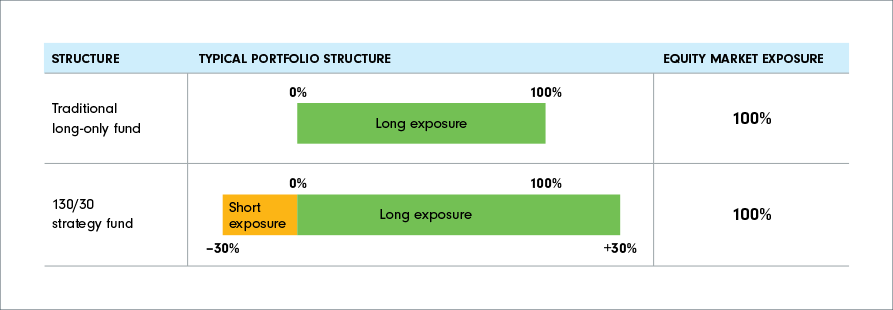
What is a long/short mutual fund?
Equity long/short is an investment strategy that can be used in alternative mutual funds. If a fund has a long/short strategy, it means that the fund has both long and short positions in stocks.
Portfolio managers buy and hold stocks they think are undervalued with the expectation they will increase in value over time (long positions) and short-sell stocks they think are overvalued (short positions).
Portfolio managers who use long/short investing strategies can increase exposure to their favoured stocks and take advantage of stocks they believe are overvalued. Both tactics increase the managers’ potential to capture positive returns by using both buy and sell recommendations. In contrast, long-only managers cannot apply the same techniques on overvalued stocks.
How do long/short strategies work?
The relative amount of long and short positions in a long/short strategy can vary. For instance, in a “130/30 fund,” the fund will have 130% of its assets in long positions for every 30% in short positions.

Let’s say portfolio managers start off with $100 of capital, in cash. They identify companies they believe to be overvalued, borrow some shares of these companies from their broker, and sell these shares in the market for $30.
The chart above shows the portfolio managers now have $130 in cash, as well as outstanding short positions worth $30. They then invest this $130 in stocks believed to be undervalued. Overall, the portfolio manager has $130 in long positions and $30 in short positions, and therefore a “130/30” strategy.
Several strategies combine long and short positions to achieve a particular result. Some examples are
1. Market neutral: This approach aims to achieve net zero exposure to the market, for example, by having an equal amount in long and short positions. This allows the capture of idiosyncratic return sources without taking on overall market risk.
2. Factor strategies: A manager might go long on value stocks and short on growth stocks, to express a strong preference for value over growth.
3. Arbitrage strategies: Several arbitrage strategies, such as merger arbitrage and capital structure arbitrage, involve long and short positions.

